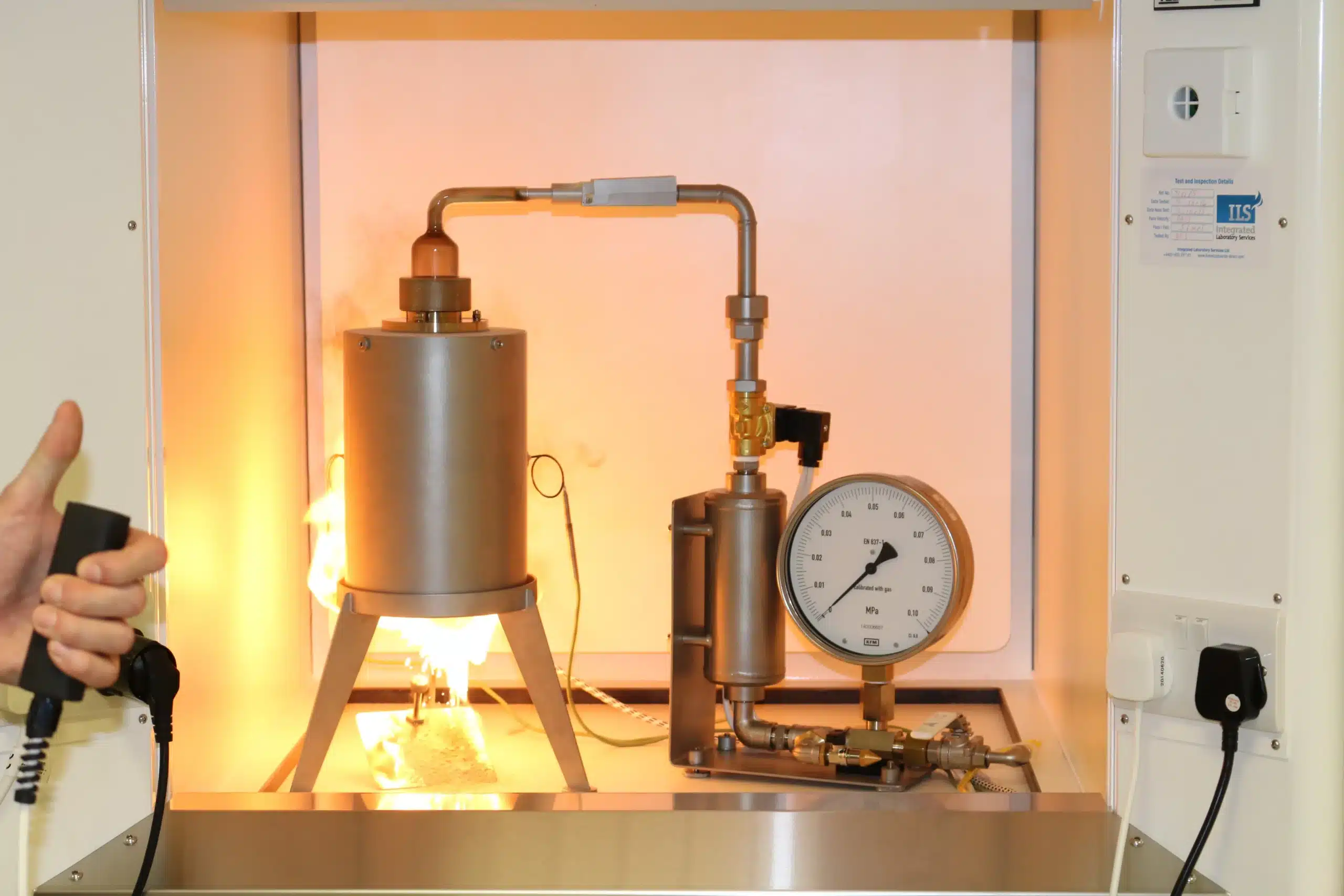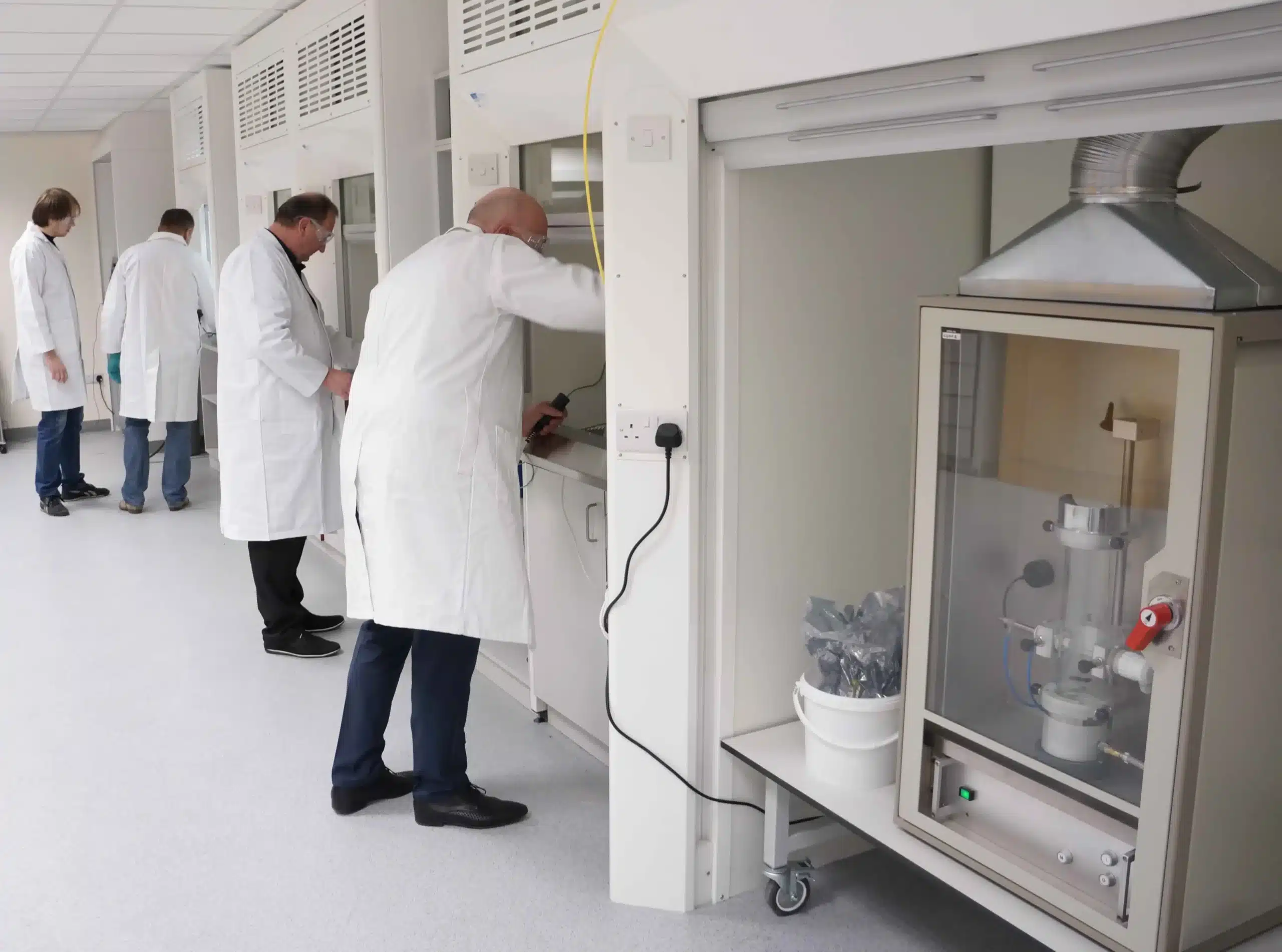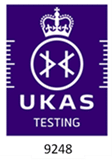Dust Explosion Testing

Our UK based combustible dust testing laboratory generates explosion & ignition data for your combustible dust samples to aid in characterising, preventing, protecting and mitigating combustible dust fires and explosion hazards.
Protecting your people, workplaces, business and the environment from an explosion, fire or other combustible dust hazard relies on the identification, mitigation and maintenance of combustible dusts.
Sigma-HSE’s ISO 17025 accredited combustible dust testing laboratory offer comprehensive testing solutions with a 7-10 day turnaround to aid you in the identification and characterisation of your hazardous materials and their related risks to combustible dust explosions.
We undertake the following combustible dust tests to simulate a primary dust explosion, secondary dust explosion and/or dust ignition:
-
Dust Combustibility (Group A/B)
-
Minimum Ignition Energy (MIE)
-
Minimum Ignition Temperature (MIT)
-
Layer Ignition Temperature (LIT)
-
Explosion Severity Test (Pmax/KST) ST Classification
-
Minimum Explosive Concentration (MEC)
-
Limiting Oxygen Concentration (LOC)
-
Burning Behaviour
UNDERSTAND YOUR PROCESS HAZARDS AT SOURCE WITH OUR DUST EXPLOSION TESTING SOLUTIONS
Find out how Sigma-HSE
can help you prevent combustible dust explosion accidents
Let us know how we can help
Discover our range of combustible dust testing solutions
DUST COMBUSTIBILITY (GROUP A/B)
Standards & Schedule of Accreditation
Dust Combustibility Test
This test is conducted to assess whether dust will form a flammable atmosphere or support flame propagation when dispersed as a dust cloud in the open air. It’s a purely qualitative test that categorises dust or powder into one of two groups:
Combustible (Group A) – Flammable or explosive
Non-Combustible (Group B) – Non-flammable or non-explosive
Varying concentrations of dust are dispersed into a 20L explosion vessel and exposed to a 2-kJ ignition source. Piezoelectric transducers then monitor the vessel’s atmosphere for ignition in the form of pressure rise.
Dusts that are found to be combustible (Group A) will present a flammable atmosphere when dispersed as a cloud. If a sufficient ignition source is present then there are serious risk of hazardous situations arising.
This can include combustible dust hazards, explosions or fires that may result in product loss and potential operator injury or fatality. Further testing is required to establish a suitable basis of safety for each process or operation of a combustible (Group A) dust and/or powder.
Dust Combustibility Benefits
Dust particles that are found to be non-combustible (Group B) will not present a flammable atmosphere when suspended in air as a cloud. As a result, dusts that are found to be Group B are not subject to the conditions stipulated in explosive atmosphere legislation DSEAR (Dangerous Substances and Explosive Atmospheres Regulations) or ATEX (Atmosphere Explosive) in regard to dust cloud explosion hazards*.
This screening approach can save the need to conduct further dust explosion dispersive testing to establish a suitable basis of safety for processing the substance.
* Ignition of a dust layer or bulk deposits through thermal decomposition may still present a risk and further dust testing should be considered.
Discover more about our Air Over Layer, Bulk Powder (Diffusion Cell), Aerated Cell and LIT tests.
MINIMUM IGNITION ENERGY (MIE)
Standards & Schedule of Accreditation
Minimum Ignition Energy Test
The Minimum Ignition Energy (MIE) test is conducted to determine the lowest spark energy that can ignite a dust when dispersed in the air as a dust cloud. A purely capacitive generated spark is used to assess electrostatic discharges (brush, spark, transitional/propagating brush discharges).
An inductively generated spark is selected for mechanical (friction, impact and grinding) or electrical (wire short, electrical contact) spark incendivity analysis.
Working through a range of dust powder concentrations, potentially combustible dust is dispersed into a 1.2L litre glass vessel using dry compressed air. These momentarily suspended dust particles/clouds are then exposed to sparks of known energy for a selected duration. Energy is then lowered, while the dust concentration and time delay are varied until the minimum ignition energy is established.
Minimum Ignition Energy Benefits
Minimum ignition energy data is typically used to define the minimum spark energy needed to ignite a cloud of combustible process material in the working environment. MIE is one of three core tests where ‘Avoidance of Ignition Sources’ is the ‘basis of safety’ for an operation. This approach tests combustible dusts to determine how sensitive they are to ignition sources such as electrostatic discharge, mechanical & electrical sparks and even a hot work surface area.
The basis of safety is often used when charging vessels from sacks, IBCs or FIBCs, pneumatic conveying, milling and tabletting operations. Combustible dust that can create a flammable atmosphere is found to be insensitive to ignition and therefore, it is easy, practical and cost-effective to ensure that an ignition source capable of initiating a dust explosion is not present.
A sub-group of ‘Avoidance of Ignition Sources’ are the electrostatic properties of products and materials used in process environments. This includes the electrostatic properties of materials being processed, electrostatic properties of containers and/or Personal Protection Equipment (PPE). This is particularly important where the process equipment or materials are found to be very sensitive to ignition.
MINIMUM IGNITION TEMPERATURE (MIT)
Standards & Schedule of Accreditation
Minimum Ignition Temperature Test
The Minimum Ignition Temperature (MIT) test is conducted to determine the lowest temperature at which a hot surface area will ignite combustible dust when dispersed in air.
A range of combustible dust concentrations are dispersed through a heated vertical ‘Godbert-Greenwald’ furnace using compressed air. Once an ignition temperature is observed, the furnace temperature is reduced. Dispersion pressure and combustible dust concentrations are varied until a minimum ignition temperature is established.
Minimum Ignition Temperature Benefits
The MIT test is one of three core tests used to access combustible dust ignition sensitivity. It is generally used when the avoidance of ignition sources is the ‘basis of safety’. Minimum ignition temperature test data is required for defining the maximum operating temperature for electrical and non-electrical equipment used in areas where test material is present.
Avoidance of ignition sources as the ‘basis of safety’, is often used for manufacturing processes such as charging vessels from sacks, IBCs or FIBCs, pneumatic conveying, milling and tabletting chemical manufacturing operations. Materials that can create a flammable atmosphere are found to be insensitive to ignition. It is therefore easy, practical and cost-effective to ensure that a source of ignition capable of initiating a dust explosion is not present.
LAYER IGNITION TEMPERATURE (LIT)
Standards & Schedule of Accreditation
Layer Ignition Temperature Test
The Layer Ignition Temperature (LIT) test is conducted to determine the lowest temperature at which a hot surface will ignite a combustible dust when settled as a dust layer.
Potentially combustible dust is placed onto an isothermally heated hotplate and formed into a 5 mm layer. Once an ignition temperature is observed, the hotplate temperature is reduced and retested. This is then repeated with fresh combustible dust until the lowest ignition temperature is established.
Layer Ignition Temperature Benefits
The Layer ignition temperature test is one of the three core tests for accessing a material’s ignition sensitivity when exposed to hot surfaces. It is generally used when the avoidance of ignition sources’ is the ‘basis of safety’ for an operation. This data is required for defining the maximum operating temperature for electrical and non-electrical equipment used in areas where test materials are present or dust accumulation may occur.
The avoidance of sources of ignition as the ‘basis of safety’, is often used for processes such as powder handling systems; charging, storage vessels, from sacks, IBCs or FIBCs, pneumatic conveying, milling and tabletting operations. Many materials that can create a flammable atmosphere are found to be insensitive to ignition and therefore, it is easy, practical and cost-effective to ensure that an ignition source capable of initiating a dust explosion is not present.
EXPLOSION SEVERITY (PMAX & KST)
Standards & Schedule of Accreditation
Explosion Severity Test
The explosion severity test is conducted to determine the maximum pressure (Pmax), maximum rate of pressure rise (dP/dt)max and the dust constant Kst value of an ignited combustible dust, dispersed in the air, as a dust cloud.
A range of potentially combustible dust concentrations are dispersed into a 20L explosion vessel (sphere) using dry compressed air. These suspended dust clouds are then exposed to a large 10 kJ chemical source of ignition and the following dust explosion pressure rise is monitored, measured, and recorded, using high-accuracy piezoelectric transducers.
Testing is conducted over a wide range of combustible dust concentrations that enable flammability curves of Pm, dP/dt & Kst to be generated, along peak values. Data created via the 20-Litre demonstrates what the maximum dust explosion pressure would be under optimum concentration.
Explosion Severity (PMAX & KST) Benefits
Data generated by the explosion severity test is predominantly used for either the design of dust explosion protection systems (venting, containment or suppression) or to confirm if a material is appropriate for processes within an established hazard protection system.
MINIMUM EXPLOSION CONCENTRATION (MEC)
Standards & Schedule of Accreditation
Minimum Explosive Concentration Test
The Minimum Explosive Concentration (MEC) or Lower Explosive Limit (LEL) test is conducted to determine the minimum quantity of combustible dust dispersed in the air, as a cloud that will form a flammable atmosphere.
A range of decreasing combustible dust concentrations are dispersed into an enclosed space (20L explosion vessel/sphere) using dry compressed air. The suspended dust cloud is then exposed to a large 2 kJ chemical ignition source and the following dust explosion is monitored, measured, and recorded, using high-accuracy piezoelectric transducers. Once ignition is achieved, a range of combustible dust concentrations are then reduced until ignition is not possible and the minimum explosion concentration is established.
Minimum Explosive Concentration Benefits
Data generated by the minimum explosive concentration test is predominantly used to ensure that levels of airborne dust are kept below the minimum threshold by which a flammable atmosphere can be created and a combustible dust explosion could occur. It may also confirm if a material is appropriate for processes with an established LEV system or a set dust extraction rate.
LIMITING OXYGEN CONCENTRATION (LOC)
Standards & Schedule of Accreditation
Limiting Oxygen Concentration Test
The Limiting Oxygen Concentration (LOC) test determines the minimum quantity of oxygen, within an atmosphere, that would be sufficient enough to enable combustible dust, when dispersed in the air, to ignite when in contact with an ignition source.
Working through a range of concentrations, dust is dispersed into a 20L explosion vessel (sphere) using dry compressed air and nitrogen. Using partial pressures, oxygen content within the sphere at the time of ignition is controlled. These suspended dust clouds are then exposed to a large 2 kJ chemical ignition sources and the following dust explosions are monitored, measured, and recorded, using high-accuracy piezoelectric transducers. Once ignition is achieved at a specific oxygen concentration, oxygen concentration is then reduced, and powder concentration is varied, until ignition is not possible, and the ‘LOC’ is established.
Limiting Oxygen Concentration Benefits
Data generated by the Limiting Oxygen Concentration test is predominantly used for either the design of nitrogen inerting systems or to confirm if combustible dusts are appropriate for processes with an established limited oxygen atmosphere. As many ventilation systems now are set at a much lower oxygen level than required, this can result in large nitrogen costs. This can be avoided or reduced, by knowing a combustible dust’s specific limited oxygen concentration and setting oxygen levels accordingly.
BURNING BEHAVIOUR
Standards
VDI 2263 and BS EN 17077
Burning Test
This dust explosion test is conducted to assess the behaviour (severity) of combustion propagation through a material deposit when ignited by an external ignition source.
A small strip is formed onto a heat-resistant, non-porous plate and ignition trials are performed using a hot (1000 °C) platinum wire. The burning behaviour is numerically rated from 1 (material does not ignite) to 6 (supports rapid combustion) in accordance with the test standards characterisation table. The rating is known as “CC” or Combustibility Class and testing is performed at ambient and elevated environmental temperature conditions.
Type of Reaction CC Reference Product No spreading
of fireNo ignition 1 Table Salt Brief ignition and rapid extinction 2 Tartaric Acid Localised combustion or glowing with practically no spreading 3 Lactose Fire spreads Glowing without sparks, (smouldering ) or slow decomposition without flame 4 Tobacco Burning with flame or spark generation 5 Sulphur Very rapid combustion with flame propagation or rapid decomposition without flame 6 Black Powder
Burning Behaviour Benefits
When the burning behaviour of solid material is known, fires or explosion dust hazards caused as a result of the introduction of open flames, hot embers or friction heat (on bearing failure) can be predicted and then avoided or mitigated. It also can be used as a screening tool to highlight materials that should be classified as a ‘flammable solid’ for safe handling and dangerous goods transportation.
GET COMBUSTIBLE DUST HELP TO DRIVE YOUR PROCESS SAFETY SUCCESS


